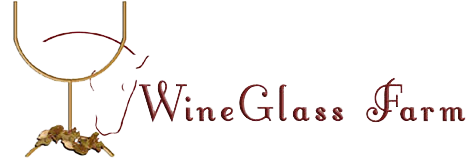*BUDAPEST
A Stallion Makes His Career
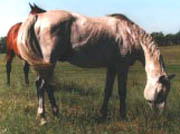 *BUDAPEST in the freedom of his spacious new home.
*BUDAPEST in the freedom of his spacious new home.
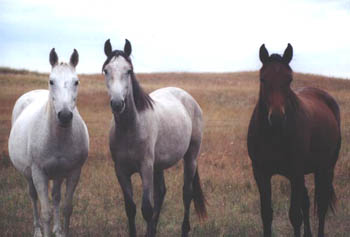 H. Tiszta, the dam of H. Bikaver, on the left with 2 *BUDAPEST 1997 fillies in 1999 at the Cooksley Ranch.
H. Tiszta, the dam of H. Bikaver, on the left with 2 *BUDAPEST 1997 fillies in 1999 at the Cooksley Ranch.
L. Rudolphi photo.
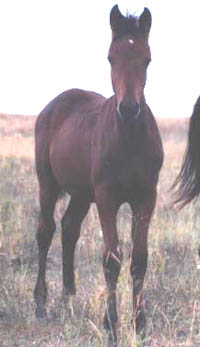 1999 *BUDAPEST filly at the Cooksley Ranch.
1999 *BUDAPEST filly at the Cooksley Ranch.
L. Rudolphi photo.
 *BUDAPEST, 1996
*BUDAPEST, 1996
The gentle eye of a noble stallion.
Photo by Dr. Huber.
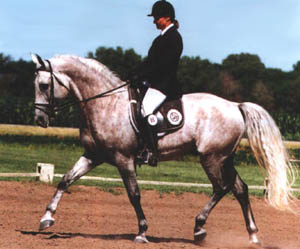 *BUDAPEST by SHAGAL out of *BIALA by 6214 Dahoman IX (Topolciancky) in a dressage test in the USA.
*BUDAPEST by SHAGAL out of *BIALA by 6214 Dahoman IX (Topolciancky) in a dressage test in the USA.
Ridden by Julie Inghram.
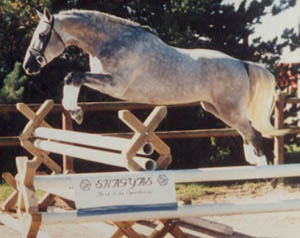 *BUDAPEST is also a capable jumper, showing an excellent form.
*BUDAPEST is also a capable jumper, showing an excellent form.
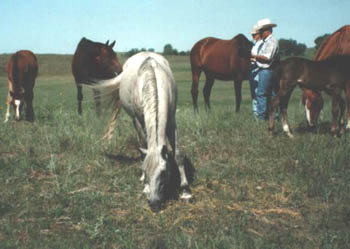 *BUDAPEST amidst his herd of Kisberer mares and foals.
*BUDAPEST amidst his herd of Kisberer mares and foals.
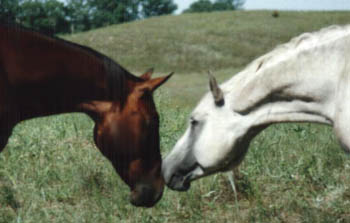 *BUDAPEST getting acquainted with one of the foundation Felver mare's at the Cooksley Ranch in 1996.
*BUDAPEST getting acquainted with one of the foundation Felver mare's at the Cooksley Ranch in 1996.
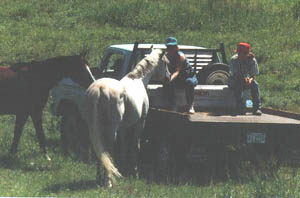 *BUDAPEST and Kisberer mare. He says hi to his owner Linda Rudolphi.
*BUDAPEST and Kisberer mare. He says hi to his owner Linda Rudolphi.
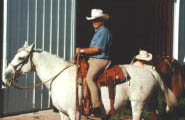 To ride a cowboy horse of the Kisberer breed is a pleasure, especially if it is so well trained and helps along the greenhorn!
To ride a cowboy horse of the Kisberer breed is a pleasure, especially if it is so well trained and helps along the greenhorn!
Written and Translated by Dr. Walter Huber
Nonnenhorn, Germany
Printed in the German Shagya Arabian Magazine:
Shagya-Araber, Band 9, 1998
I believe, if a stallion could express his desires, he would wish for a band of broodmares, a good pasture, water and a lot of free space to run. That sounds like a fairy tale in our modern times, but it is still feasible, as I witnessed myself. In Nebraska near the little town of Anselmo, the SHAGAL son *BUDAPEST does live exactly such a gentleman’s or respected sire’s life of this kind at the Cooksley Ranch.
Together with his owner Linda Rudolphi, I visited him in August of 1996 after attending the Olympic Games in Atlanta.
The Cooksley Family breeds Hungarian Horses, to be more exact Kisberers, at their 10,000-hector ranch.
This seems odd in the land of Quarter Horses and particularly at a ranch where cowboy horses are used daily for stock work. At the Cooksley ranch about 2,000 head of cattle are kept for meat production.
The ancestors of these horses (the Hungarians at the Cooksley ranch) originate from imports from the Kisber National Stud in Hungary.
They had been brought to America at the end of World War II. In 1947 the Cooksley family commenced breeding Kisberers.
Here you find the headquarters of the “Hungarian Horse Association of America.”
In it’s country of origin this breed was crossed for refinement with Thoroughbreds, Trakehners, Shagya-Arabians (formerly called “Arabian Race”).
Now one considers the time is right to take up this practice again. To this end *BUDAPEST was chosen. He has what it takes and his track record is impressive.
*BUDAPEST has received many awards and trophies from the North American Shagya-Arabian Society, the Arabian Sport Horse Association, Inc., the Illinois Centerline Dressage Club, the American Endurance Ride Conference, the United States Dressage Federation, and the Southern Illinois Distance Riding Association.
*BUDAPEST, like his sire SHAGAL, is a strong boned stallion with ground covering movements. He exudes Arabian flair and friendliness. His dam, *BIALA is by 6214 DAHOMAN IX (1954 Topolcianky) out of 92 EMISJA from Janow Podlaski Stud in Poland – an interesting outcross pedigree on the damside! The breeder of *BUDAPEST is Ulla Nyegaard of Denmark. He was imported in-utero into the United States.
At the Cooksley Ranch *BUDAPEST is turned out together with 10 broodmares. From spring to fall he grazes a huge territory with the mares and their foals. In October the herd returns to the homestead. Quickly the stallion developed his normal instincts though this situation was pretty new to him. Mares, foals, and the stallion get along just fine and the Cooksleys hope by fall all the mares will be pregnant.
When we first arrived, we visited *BUDAPEST that very evening in his huge pasture. It was a moving experience for me to see a stallion and his herd peacefully grazing in the last soft pink sun rays of the day.
*BUDAPEST watched us with friendly attention, while constantly keeping an eye on his herd. The endless sweep of the prairies gave me a feeling of quiet harmony. Buffaloes followed by Indian tribes once crossed this land.
Now purebred Hungarian horses are bred and raised with care here by an American rancher, surely remarkable and at the same time a unique way of connecting distant nations.
Hopefully, *BUDAPEST will produce many good foals with these quality broodmares.
Every stallion breeding in another horse population serves as an important ambassador of our breed. Only if the Shagya is crossed into other riding horse breeds, his sport qualities become fully apparent, as exemplified in WHITE GIRL by BAJAR, who unfortunately had to be pulled out before the cross-country in Atlanta. Or in JAEGERMEITSTER, a GAZAL (4736 GAZAL VII-19) grandson, who completed all phases of the Olympic Three Day event in a beautiful manner and won a Team Bronze Medal. The Shagya-Arabian has the advantage over the purebred Arabian, in that fewer generations need to pass before the positive influence of the Arab becomes evident in competition when using the Shagya.
The next day we drove with the Landrover through this vast terrain to look for the cattle herds. I found the landscape to be pristine and varied, full of flowers, herbs and creatures great and small. We drove across the softly undulating countryside with the typical windmills drawing the precious water from the deep. Near the wells grazed the robust red and white Herefords with their intelligent faces.
The following day a Kisberer horse was saddled for me. I was riding the perfect cowboy horse, which knew of course so much more than me! My meager attempts at cutting were accepted favorably and he cooperated willingly. The breeding goal is not the cowboy horse but a versatile sporthorse. Kisberer horses are used in all modern equestrian disciplines. I saw a video of Olympic Even rider David O’Conner (Team Silver Atlanta) competing successfully at Advanced level on a gelding bred by my host.
America is still the land of unlimited opportunities. It offers also to us Shagya breeders a great chance to further develop our breed with the help of American ideas and enthusiasm. We should benefit from this unique possibility and help our American friends to get new bloodlines for improving the quality of their horses. Their zeal is great as I found out in our intensive nightly conversations. But the population of the Shagya-Arabian is still too small.
